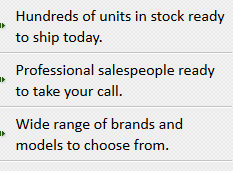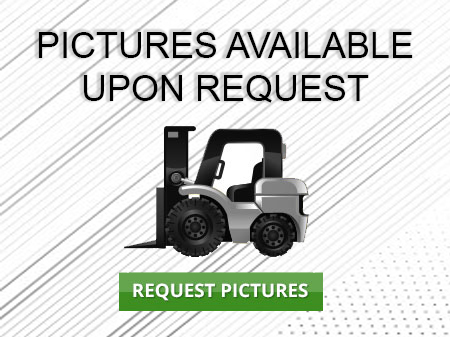Rough Terrain Forklift Rialto
Used Rough Terrain Forklift Rialto - Forklifts rely on two forks to unload, load and transport items. Forklifts fall into two main categories, industrial forklifts and rough terrain forklifts.
The first category of forklifts, industrial forklifts, are mostly used in warehouses and at loading docks on surfaces that are relatively smooth and level. By contrast, the second category of forklifts, rough terrain forklifts, are commonly used to run on uneven and rocky surfaces. Commonly found at exterior construction sites, rough terrain forklifts have the tires, size and weight capacity to handle heavy loads. The tire type is one of the key differences between rough terrain and industrial forklift units. Common road tires, cushion tires are the main kind found on industrial forklifts. Rough terrain forklifts, on the other hand, are fitted with pneumatic tires, a type of tractor tire allowing for better traction and flotation properties. Internal combustion engines can power industrial forklifts; however, more often they rely on an electrical source such as a fuel cell or better. Rough terrain models typically rely on an internal combustion engine.
Types of Class 7 Rough Terrain Forklift Trucks
The three types of Class 7 Rough Terrain Forklift Trucks include the rotating telehandler forklifts, telehandler forklifts and straight mast forklifts.
Every rough terrain forklift truck is designed to operate on disturbed ground and difficult locations commonly found in military and construction atmospheres. The rough terrain models travel and perform well in difficult locations. In the case of rough terrain forklift operations, extra consideration must be given while raising loads in these rough, variable conditions to prevent tip-over. For safety reasons, it is vital the forklift maintains stability before moving, lifting or lowering. Adequate stability and proper lifting techniques need to be implemented to keep the forklift stable on the ground.
Straight Mast Forklifts
Straight mast forklifts are designed to transport building materials around a range of rough terrain sites such as demolition and construction sites. Pneumatic cushion tires allow this forklift better maneuverability and accessibility around difficult terrain. Uneven ground and rough surfaces are no match for pneumatic tires. It is common for straight mast forklifts to come with 2-wheel or 4-wheel drive. The majority of straight mast forklifts rely on propane or diesel fuel to equip them for interior short-term jobs. However, these machines are best suited for outside jobs. The lift capacities of straight mast forklifts are similar to most standard forklifts with a range of approximately 5,000 to 36,000 pounds.
Telehandler or Telescopic Handler Forklifts
Telehandler or telescopic handler forklift trucks are equipped with a telescoping boom, giving them their name. This specially designed boom allows the forklift truck to pick up loads and place them at differing heights in front of the unit. The operator can achieve enhanced flexibility with better reach during load placement.
Standard telehandler forklift units are long and low. They are designed with two wheels located at the front of the forklift with a different pair of wheels found close to the end of the unit. Mounted at the back of the forklift, the telescopic boom is on a pivot that is located many feet above the forklift frame. The left side of the machine houses the cab and the hydraulic fluid tank and the fuel tank are found opposite to the cab. The forklift engine and transmission are situated along the center of the machine. This common configuration allows for a balanced forklift which is necessary for the basic stability of the machine which lifting, transporting and lowering loads.
Telehandler forklifts provide much greater lift heights when compared to a standard forklift. Also called compact telehandlers or high-reach telehandlers, these forklift trucks can lift their full load capacities from 18 feet, for the compact telehandlers, to 56 feet, for the high-reach telehandlers, into the air. The load capacities of these machines range from five thousand pounds to twelve thousand pounds.
All-terrain forklifts often include all-wheel steering which allows for greater maneuverability. This, along with power shift transmission and other steering features, means that the operator can move the lift in as close proximity to the work area as possible.
The latest telehandler models feature ergonomic upgrades for ultimate operator comfort. Spacious cabs and tilted steering are some of the items redesigned for the ultimate comfort and productive features. These ergonomic upgrades have been shown to lessen repetitive stress injuries and lessen operator fatigue.
Most telehandler forklifts rely on a single joystick. The joystick is essential for controlling the boom functions and the hydraulics responsible for forward operation.
These machines can use non-marking tires to allow them to be suitable for maintenance in stadiums and on buildings or billboards and sign operations.
Rotating Telehandler or Roto Telescopic Handler Forklifts
Roto telescopic handler forklifts or rotating telehandlers have numerous items in common with the standard telehandler model. The rotating telehandler can lift excessive loads to extreme heights safely and efficiently. However, these forklifts have the added ability to rotate the forklift on a turntable. The rotating function allows the forklift to swivel a full 360 degrees around, enabling access a much larger work area without having to reposition the forklift.
Because of this additional feature, rotating telehandlers often have a second joystick to allow operation of the rotation function apart from the lift function. Useful additional features may be added to your standard telehandler or rotating telehandler including 4WD, increased traction via minimized slip differential on the rear axle, and power-assist steering.
Any machine with rotation capabilities will have additional safety measures to consider. Rotating telehandler rough terrain models come with standard stabilizers to establish more safety while rotating loads back and forth. Certain rotating telehandlers operate without stabilizers; minimizing the time it takes to reposition the machine and move to other workplace locations.
Rotator telehandlers are usually smaller than their fixed cab counterparts, the standard telehandler. Understandably, rotator telehandler machines can handler smaller load capacities compared to their standard telehandler counterparts. Load capacities for rotating telehandlers usually range between 4,000 and 10,000 pounds, with lift heights ranging from 15 to 80 feet.
Standard and rotator telehandlers can double as a crane when outfitted with specific winch accessories. This means that these forklifts can sometimes allow a project to forego the need for a crane at the jobsite, saving time, expense and workspace.
Advancements for Rough Terrain Forklifts
Numerous attachments can be found for rough terrain forklifts including articulating booms, rotating fork carriages, booms, winches and similar items. More rough terrain forklift attachments will be unleashed onto the market in future years thanks to their ability to make the forklift more multi-purpose than ever before.
The majority of advancements will be delivered as safety features built to enhance the rough terrain models. Automatic load restriction units and certain safety features have started being implemented. This system weighs a load automatically and then calculates the safe reach distance of the load while considering the extension and boom angle. An alarm sounds once the safe distance is reached, warning the operator to make load weight, reach distance or boom angle adjustments.
Rough Terrain Forklift PDF
Stock Number: DP-MAN008 GL
Make: MANITOU
Model: MH25-4T
Year: 2016
| Stock Number |
DP-MAN008 GL |
| Make |
MANITOU |
| Model |
MH25-4T |
| Year |
2016 |
| Category |
Rough Terrain Forklift |
Stock Number: 267846 GL
Make: Liftking
Model: LK12000
Year: 2003
| Stock Number |
267846 GL |
| Make |
Liftking |
| Model |
LK12000 |
| Year |
2003 |
| Category |
Rough Terrain Forklift |
Stock Number: 209058 GL
Make: LIFTKING
Model: LK12M42
Year: 2015
| Stock Number |
209058 GL |
| Make |
LIFTKING |
| Model |
LK12M42 |
| Year |
2015 |
| Category |
Rough Terrain Forklift |
Stock Number: 208325 GL
Make: MANITOU
Model: M50.4
Year: 2015
| Stock Number |
208325 GL |
| Make |
MANITOU |
| Model |
M50.4 |
| Year |
2015 |
| Category |
Rough Terrain Forklift |
Stock Number: LS15257 GL
Make: JCB
Model: 930
Year: 2013
| Stock Number |
LS15257 GL |
| Make |
JCB |
| Model |
930 |
| Year |
2013 |
| Category |
Rough Terrain Forklift |
Stock Number: EQC008213 GL
Make: MANITOU
Model: M50
Year: 2017
| Stock Number |
EQC008213 GL |
| Make |
MANITOU |
| Model |
M50 |
| Year |
2017 |
| Category |
Rough Terrain Forklift |



























